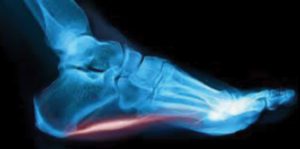By Luga Podesta, MD
Director of Regenerative Sports Medicine – Bluetail Medical Group-Naples


Plantar fasciitis develops gradually, typically causing pain in the arch of the foot or close to the heel when you first get out of bed in the morning or after you get up from a seated position and take your first few steps. It usually affects just one foot, but it is not uncommon for it to occur in both feet. Pain occurs from stretching out the tight plantar fascia when the foot is placed on the floor and lessens after walking.
Plantar fasciitis was traditionally thought to be an inflammatory condition of the plantar fascia of the foot. It is now felt to be a degenerative injury of the collagen fibers that make up the thick, broad band of tissue that runs from the heel to the ball of the foot making up the arch of the foot. Plantar fasciitis is the most common cause of heel pain.
Normally, the plantar fascia acts like a shock absorber supporting the arch in your foot. If tension on the plantar fascia becomes too great, small tears in the fascia can occur. Repetitive stretching and tearing can cause the fascia to become irritated or inflamed causing it to thicken. As the fascia thickens it loses flexibility and strength.
Factors that increase the risk for developing plantar fasciitis include abnormal foot mechanics such and being flatfooted, having a high arch or walking with a gait pattern that might cause an abnormal weight distribution across the foot. Excessive body weight, exercises that place significant stress on the heel of the foot and improper shoe wear (no arch, thin soled, loose fitting) are risk factors for developing plantar fasciitis.
Treatment for plantar fasciitis can be difficult. Rest from the activity causing the injury is the first line of treatment. Stretching the plantar fascia at night while sleeping in addition to while awake will help diminish the tightness experienced after rest. The application of cold therapy or ice can be extremely helpful. This is easily accomplished by rolling the painful arch over a frozen water bottle. Physical therapy is utilized in those cases that do not respond to early treatments. The judicious use of non-steroidal anti-inflammatory medications or corticosteroids can also be beneficial. The use of night splints to stretch the plantar fascia while sleeping or orthotics worn in the shoes can also be beneficial.
For difficult cases, newer non-surgical treatment methods including orthobiologic treatment with Platelet Rich Plasma (PRP), Bone Marrow Concentrate (BMC) or extracorporeal shock wave therapy may be indicated.
Early treatment is imperative to limit the duration of the acute stages and prevent plantar fascia rupture from occurring, which will stop us in our tracks.
Bluetail Medical Group-Naples is Southwest Florida’s most experienced and skilled regenerative orthopedic physicians. Our skilled and experienced physicians with over 15 years of regenerative medicine experience can help get you back on your feet as quickly as possible.
Bluetail Medical Group
239-631-1960 | BluetailMedicalGroup.com
 Southwest Florida's Health and Wellness Magazine Health and Wellness Articles
Southwest Florida's Health and Wellness Magazine Health and Wellness Articles
